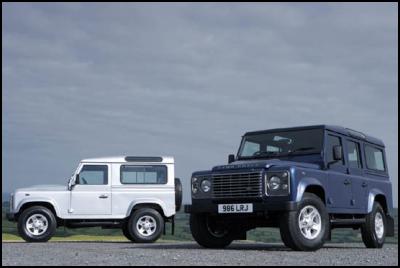Defender refined for 2007
Defender refined for 2007

Click to enlarge
media bulletin – Land Rover
Defender refined for 2007
August
29
Greater ability both on-road and off-road plus
increased comfort, performance and refinement are among the
major improvements introduced for the Land Rover Defender
for 2007.
A new 2.4-litre turbo diesel engine offers increased torque and improved driveability while the new six-speed gearbox provides a lower first gear ratio, for better off-road control, and a high sixth gear for improved cruising refinement.
Inside the vehicle, a new facia improves ergonomics, whilst new seating improves comfort for all occupants, from the four-seat Defender 90 to the five-seat 110 and 130 models. A seven-seat Defender 110 is also available.
The latest in a long line of evolutionary updates to a vehicle whose roots date back to 1948 (since when nearly 1.9 million units have been sold), the 2007 model year changes maintain Defender’s relevance while enhancing its functionality, versatility and durability. The vehicle is due to be launched in New Zealand in the second quarter of next year.
Since the current model’s introduction in 2002, Defender has consistently sold an average of 25,000 units a year worldwide. Retail and utility customers, armed forces and NGOs in over 100 countries value Defender’s class-leading blend of towing and load-carrying versatility, alongside the vehicle’s extraordinary strength, robustness and capability. The unique combination of these attributes helps account for the model’s exceptionally high standards of customer loyalty.
Defender’s new 2.4 litre, four-cylinder engine represents a major step forward in terms of refinement and driveability. Torque output is higher than the outgoing engine right across the usable rev range, and the 360 Nm peak is delivered at only 2000 rpm; over 315 Nm of torque is available from 1500 rpm to 2700 rpm.
Engine peak power output is 90 kWs, with more than 90 per cent of peak power available from less than 2200 rpm to over 4350 rpm – over 60 per cent of the usable rev range.
Based on a cast-iron block, the engine features an alloy, 16-valve cylinder head with Denso common rail fuel injection. A new Garrett variable geometry turbocharger also helps ensure throttle response is improved over the outgoing engine. The engine’s lubrication and sealing systems have been specially developed to cope with Defender’s onerous range of operating angles.
The new GFT MT 82 six-speed gearbox provides a much wider ratio spread than before; the lower first gear offers a reduction in crawl speed and combines with the engine’s increased torque output to make towing on-road and off-road even easier. The increased engine torque also helps in-gear acceleration, and has allowed the new sixth gear to be set 20 per cent higher than the outgoing model’s top gear. This helps to improve real-world cruising refinement and fuel economy. Reductions in clutch and gear-change loads make day-to-day living with Defender significantly easier.
Changes to the vehicle exterior have been kept to a minimum, with a revised bonnet profile the only clue to the new Defender’s increased capability.
Defender’s new facia is based on a single, large moulding supported on a robust steel rail to help eliminate squeaks and rattles. Instruments from Land Rover’s Discovery 3 provide clear, concise information to the driver, and details like all-LED instrument illumination help ensure high standards of reliability. Two console options are available: a practical open-tray design that keeps contents to hand and a large, lidded design that provides an impressive 14-litres of stowage.
In-car entertainment systems have been upgraded to take advantage of Defender’s improved refinement. For the first time, high-mounted tweeters are available in Defender and work in conjunction with the new speaker installation for significantly improved clarity and sound reproduction. An auxiliary/MP3 audio input socket is also available.
The new facia houses an all-new heating and ventilation system. Cabin airflow is up almost 50 per cent, with new aluminium plate and fin heat exchangers helping deliver impressive performance.
Seating is also comprehensively improved. New, taller front seats are designed to improve back support and head restraint ergonomics.
Robust, more supportive second row seats are introduced too. Defender 90 Station Wagon second row occupants benefit from a pair of individual, full-size, forward-facing rear seats. Seat trims include durable all-vinyl and cloth specifications; a half-leather option is also available to add a touch of luxury to the new cabin. Three-point safety belts are specified for all seating positions.
Upgraded sound insulation, the common rail engine’s excellent combustion control and the significantly higher top gear all contribute to a substantial overall improvement in cabin refinement.
Defender’s unique vehicle architecture has been retained. The chassis frame is available in three different wheelbases, and in both standard and heavy-duty guise (for even greater load-bearing capabilities). A total of 14 separate body styles – from pick-ups and soft-tops to crew cabs and station wagons – are produced on the mainstream production line. Beyond this, Land Rover’s Special Vehicle Operations team offer a range of products from standard drop-side or box-body conversions to bespoke design and build adaptations into ambulances, mobile hydraulic platforms and even airport fire tenders – all of which are covered by Land Rover’s extensive warranty.
ENDS


 NIWA: Flooding From Underneath - New Tool Reveals Shallow Groundwater Elevations
NIWA: Flooding From Underneath - New Tool Reveals Shallow Groundwater Elevations Commerce Commission: Commission Concludes Auckland Airport Over-charging By $190 Million
Commerce Commission: Commission Concludes Auckland Airport Over-charging By $190 Million The Future Is Rail: Ferry Decision - Common Sense Prevails
The Future Is Rail: Ferry Decision - Common Sense Prevails Aotearoa Food Rescue Alliance: Grocery Market Reform Must Include Mandatory Food Rescue Partnerships
Aotearoa Food Rescue Alliance: Grocery Market Reform Must Include Mandatory Food Rescue Partnerships Hugh Grant: Zero Trust Security - A Buzzword Or The Ultimate Protection?
Hugh Grant: Zero Trust Security - A Buzzword Or The Ultimate Protection? Bill Bennett: Comcom revisits fibre rules as competition intensifies
Bill Bennett: Comcom revisits fibre rules as competition intensifies



